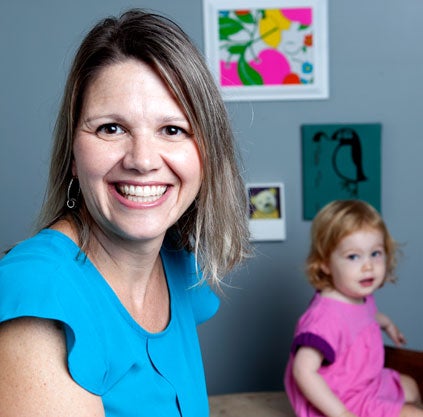 If the experiment is a bit of a tease, at least it’s all in the name of science. Psychology professor Amy Kolak will walk into a room, place a few toys on a table and prepare to leave. But before walking out, she says one thing to the 2-year-old and his or her parents: “We’re going to play with the toys, but don’t touch them until I return in a few minutes.”
If the experiment is a bit of a tease, at least it’s all in the name of science. Psychology professor Amy Kolak will walk into a room, place a few toys on a table and prepare to leave. But before walking out, she says one thing to the 2-year-old and his or her parents: “We’re going to play with the toys, but don’t touch them until I return in a few minutes.”
It’s a command that sows fear into the hearts of toddler and parents alike. What do you mean we can’t touch the toys? What are we supposed to do?
Kolak knows about two-thirds of her research subjects will ultimately disregard the instructions and touch the toys. But the other third will employ all sorts of techniques in order to self-regulate their behavior. Toddlers might sing or dance to distract themselves, run in circles or engage their parents in conversation – anything to stop themselves from thinking about those toys.
“There are some really, really clever kids,” says Diana Devine, a senior double majoring in psychology and French, who has researched self-regulating behavior with Kolak since her freshman year. “Some of these kids have blown me away.” Some toddlers, Devine says, deal best with temptation by ignoring the toys and keeping them out of sight. But one boy chose the opposite tack and stared down the toys for nearly three minutes before his will gave out. Sometimes, parents will even move their children away to prevent their progeny from grabbing the items on the table.
When the toy experiment is finished, Kolak repeats the procedure, but this time she puts a wrapped gift on the table. “Don’t touch,” she tells the toddlers again, “until I return to the room.” And then Kolak turns to the parents, asking them not to reinforce the instructions, but to just leave their children to their own devices.
Again, just about one-third of the toddlers will be able to resist opening the wrapped gift. Among this population, recalls Devine, is a toddler who tried to trick his father into opening the gift, telling him, “Dad, Dad, you have a present. You should go open your present.”
But what’s interesting, says Kolak, is that when the toy is wrapped, the toddlers more often rely on themselves to self-distract instead of turning to their parents.
It’s no easy task for toddlers to self- distract, or self-regulate their behavior. As one parent described the challenge Kolak imposes on the toddlers: “It’s like they’re being asked to do mental gymnastics for an hour.”
The gymnastics have a purpose. The self-regulation of behavior, Kolak explains, is a critical skill for people of all ages.
“People are always working to control behavior,” says Kolak. “They’re always struggling to manage their own behavior in the face of changes in their environment.”
To discover predictors for self- regulating behavior and to obtain a sense of how self-regulating behavior changes over time, Kolak has begun to retest some of her research subjects, comparing their behavior as 2-year-olds to their behavior today as 5-year-olds. She also examines the actions of parents, and their influence on a child’s behavior. All told, if there have been changes in the toddlers’ ability to self-regulate, Kolak seeks to understand what shaped their behavioral shifts.
The insights she gains can help parents and educators better teach and rear young children.
“How can we improve children’s developmental outcomes?” asks Kolak. “Kids don’t come with a manual or workbook that is unique to the individual child, and therefore, it can be challenging for parents to feel confident they are raising their children to succeed in the world.”
In today’s world, where so-called “helicopter” parents seem increasingly prevalent, Kolak says research has indicated that kids have fewer opportunities to self-regulate, as their behavior is frequently moderated by adults. Later in life, this deficit could lead to depression and a reduced ability to problem solve.
But life is full of challenges, notes Kolak, and a child is best served when he or she is given a set of skills to navigate such difficulties. Ultimately, she says, children must learn to survive on their own, and it’s never too young to start.




